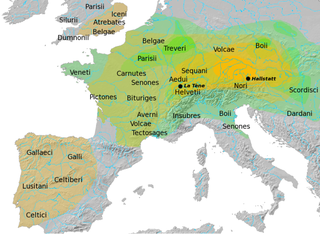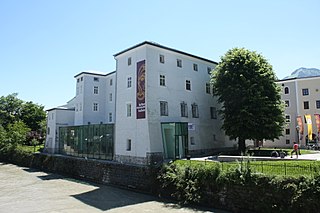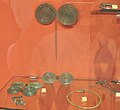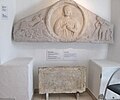
The La Tène culture was a European Iron Age culture. It developed and flourished during the late Iron Age, succeeding the early Iron Age Hallstatt culture without any definite cultural break, under considerable Mediterranean influence from the Greeks in pre-Roman Gaul, the Etruscans, and Golasecca culture, but whose artistic style nevertheless did not depend on those Mediterranean influences.

The Urnfield culture was a late Bronze Age culture of Central Europe, often divided into several local cultures within a broader Urnfield tradition. The name comes from the custom of cremating the dead and placing their ashes in urns which were then buried in fields. Over much of Europe, the Urnfield culture followed the Tumulus culture and was succeeded by the Hallstatt culture. Some linguists and archaeologists have associated this culture with the Proto-Celtic language, or a pre-Celtic language family.

Hallstatt is a small town in the district of Gmunden, in the Austrian state of Upper Austria. Situated between the southwestern shore of Hallstätter See and the steep slopes of the Dachstein massif, the town lies in the Salzkammergut region, on the national road linking Salzburg and Graz.

The Hallstatt culture was the predominant Western and Central European culture of Late Bronze Age from the 12th to 8th centuries BC and Early Iron Age Europe from the 8th to 6th centuries BC, developing out of the Urnfield culture of the 12th century BC and followed in much of its area by the La Tène culture. It is commonly associated with Proto-Celtic populations. Older assumptions of the early 20th century of Illyrians having been the bearers of especially the Eastern Hallstatt culture are indefensible and archeologically unsubstantiated.

The Salzkammergut is a resort area in Austria, stretching from the city of Salzburg eastwards along the Alpine Foreland and the Northern Limestone Alps to the peaks of the Dachstein Mountains. The main river of the region is the Traun, a right tributary of the Danube.

The Natural History Museum Vienna is a large natural history museum located in Vienna, Austria. It is one of the most important natural history museums worldwide.

Traun is a river in the Austrian state of Upper Austria. Its source is in the Totes Gebirge mountain range in Styria. It flows through the Salzkammergut area and the lakes Hallstätter See and Traunsee. The Traun is a right tributary of the Danube, which it meets near the city of Linz. Other towns along the river are Bad Aussee, Bad Ischl, Gmunden, Wels and Traun.

Alcimoennis is the name widely attached to a Celtic Oppidum, or hill fort above the modern town of Kelheim in Bavaria, Germany. The name comes from Ptolemy, who in his Geography, only mentioned the name and described the location of the settlement. There is some controversy over the identification of the Kelheim remains with Alcimoennis, but it is still widely accepted.

The Oppidum of Manching was a large Celtic proto-urban or city-like settlement at modern-day Manching, near Ingolstadt, in Bavaria, Germany. The settlement was founded in the 3rd century BC and existed until c. 50-30 BC. It reached its largest extent during the late La Tène period, when it had a size of 380 hectares. At that time, 5,000 to 10,000 people lived within its 7.2 km walls. Thus, the Manching oppidum was one of the largest settlements north of the Alps. The ancient name of the site is unknown, but it is assumed that it was the central site of the Celtic Vindelici tribe.

The Glauberg is a Celtic oppidum in Hesse, Germany consisting of a fortified settlement and several burial mounds, "a princely seat of the late Hallstatt and early La Tène periods." Archaeological discoveries in the 1990s place the site among the most important early Celtic centres in Europe. It provides unprecedented evidence on Celtic burial, sculpture and monumental architecture.

The Imperial Natural History Museum or Imperial Royal Natural History Court Museum of Austria-Hungary was created by (Kaiser) Emperor Franz Joseph I during an extensive reorganization of the museum collections, from 1851 to 1876, and opened to the public on August 10, 1889. Located in Vienna, the Museum was named in German as "K.k. Naturhistorisches Hofmuseum".

The Vix Grave is a burial mound near the village of Vix in northern Burgundy. The broader site is a prehistoric Celtic complex from the Late Hallstatt and Early La Tène periods, consisting of a fortified settlement and several burial mounds.

The Burgstallkogel is a hill situated near the confluence of the Sulm and the Saggau river valleys in Southern Styria in Austria, about 30 km south of Graz between Gleinstätten and Kleinklein. The hill hosted a significant settlement of trans-regional importance from 800 BC to about 600 BC. Surrounding the hill is one of the largest Iron Age necropolises in continental Europe, originally composed of at least 2,000 tumuli.

Celtic Luxembourg existed during the period from roughly 600 BC until 100 AD, when the Celts inhabited what is now the territory of the Grand Duchy of Luxembourg. Their culture was well developed, especially from the 1st century BC, as can be seen from the remains of the extensive Titelberg site in the far southwest of the country and from the impressive finds in several tombs and necropolises in the Moselle valley and its surroundings.

The Bavarian State Archaeological Collection in Munich is the central museum of prehistory of the State of Bavaria, considered to be one of the most important archaeological collections and cultural history museums in Germany.

Johann Georg Ramsauer was an Austrian mine operator and the director of the excavations at the Hallstatt cemetery from 1846–1863. He spent his life working for the state service of the mines, moving from an apprentice to Bergmeister. During this time, he lived in the Rudolfsturm, a medieval fortress, where he raised 24 children. He kept comprehensive field notes, including magnificent watercolor drawings of grave arrangements and artefacts, which were never published but rather became the protocol manuscripts.

The Minett Park Fond-de-Gras is an open-air museum including Fond-de-Gras, the village of Lasauvage, the former open-pit mine "Giele Botter" and the Celtic oppidum of Titelberg. Thanks to its wide thematic variety, the Minett Park offers many complementary activities, the red wire of which is iron ore.
The Hallstatt Archaeological Site in Vače is an Eastern Hallstatt archaeological site in Klenik, a village near Vače on the border between the Styria and Lower Carniola regions in central-eastern Slovenia. It is best known for the Vače Situla, one of the most notable archaeological treasures of Slovenia.

The Keltenmuseum in Hallein near Salzburg contains major discoveries from the La Tene period of the Iron Age which come from burials in the area surrounding the nearby Hallein Salt Mine, at Dürrnberg. The Museum was founded in 1882 and was housed in the Bürgerspital. In 1930 it was moved into the Rathaus and from 1952 occupied a gateway of the town or stadt's fortifications. In 1970 the name was changed to Keltenmuseum and the museum was moved into the former Salt Offices on the Pflegerplatz, which fronts the river Salzach. In 1980 the Museum staged a major exhibition "Die Kelten in Mitteleuropa", which demonstrated the wealth of discoveries that were being made at the Hallein. In 1993-4 the Austrian architect Heinz Tesar drew up plans for the conversion and extension of the Museum and on 1 January 2012 the Museum became a constituent part of Salzburg Museum.

Heidengraben is the name given to the remains of a large Celtic fortified settlement (oppidum) dating to the Iron Age, located on the plateau of the Swabian Jura in the districts of Reutlingen and Esslingen in Baden-Württemberg, Germany. The settlement was in use from about the late 2nd century BC to the early 1st century BC. By surface area, Heidengraben is the largest oppidum in all of mainland Europe.


















































